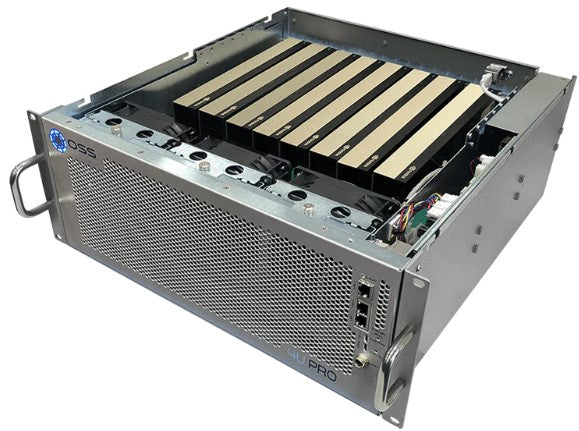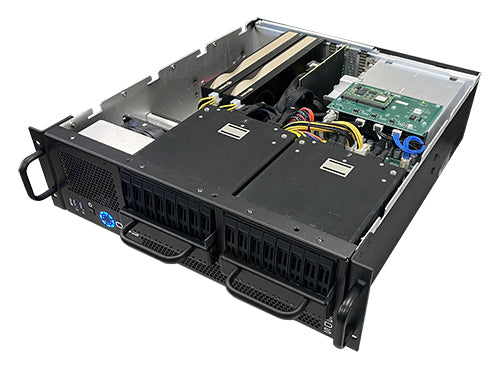
By Matthew Elwell, Project Engineer
Since the early stages of the 21st century, Peripheral Component Interconnect Express (PCIe) has established itself as the standard bus for workstation and server motherboards to interface with graphics cards, network cards, and many other categories of add-in cards. The throughput of full-length connections are heavily dependent on the generation of PCIe products being used, seen in the table below – and as the need for higher system performance in artificial intelligence and other computing applications intensifies, so does the demand for newer PCIe Gen5 products.

Leveraging years of experience in PCIe and PCBA design, One Stop Systems is a leader in the field of next-generation compute and storage scale-out. OSS offers a wide variety of expansion solutions ranging from individual board-level products to complete link kits compatible with any Windows or Linux-based servers. Through the use of OSS expansion products, a single PCIe slot can scale out to support up to 7 times as many slots, significantly increasing the compute density of the server network.
The Gen5 4U Professional Accelerator System (4UP) serves as the apex of OSS’ expansion products, with the capability of scaling out 8 double-wide add-in cards from a single host PCIe slot. In one use case, the system can support 8 NVIDIA H100s. An alternative system configuration can support up to 16 single-width PCIe Gen5 x8 slots for FPGA, NIC, or hybrid configurations. The 4UP’s rugged chassis and U-BMC system monitoring additionally ensure that the enclosure has the power and cooling to support the needs of high intensity computing for edge deployments.

Joining One Stop Systems’ roster of PCIe Gen5 products is the Gen5 3U Short Depth Server (SDS). First developed as a rugged server platform using PCIe Gen4 architecture, the 3U SDS has seen successful deployment as an all-in-one AI compute and storage solution in the autonomous long-haul trucking industry, among other applications. The new Gen5 SDS will maintain the same form factor as the original, while supporting multiple single and dual socket PCIe Gen5 motherboards. The Gen5 3U SDS will also incorporate the OSS Unified-BMC for advanced system monitoring and control of the entire host system, far surpassing the performance of the IPMI system management used in the Gen4 SDS. Additional features of the 3U SDS includes the capability of supporting two bulk-removable and hot-swap canisters of Gen5 NVMe storage and a variety of front/rear I/O customization options.
As the use cases and requirements of high-performance AI applications at the edge continue to evolve, the demand for robust compute servers will always be present. OSS is proud to support HPC at the edge through top-of-the-line products like the Gen5 3U SDS and 4UP and will continue to develop high quality systems as the industry moves towards PCIe Gen6 and beyond.
Click the buttons below to share this blog post!

By: Jaan Mannik – Director of Commercial Sales
The term AI, or Artificial Intelligence, is everywhere nowadays and has quietly woven itself into the fabric of our daily lives. It powers the recommendations we see on streaming platforms, the navigation apps that guide us through traffic, and even the virtual assistants that answer our questions in seconds. From optimizing energy use in smart homes to predicting market shifts in finance, AI has become the invisible engine driving convenience, efficiency, and insight across industries.
In manufacturing, AI-driven robots collaborate with humans to streamline production. In agriculture, machine learning models monitor crops, forecast yields, and conserve resources. Retailers use predictive analytics to anticipate consumer needs before customers even express them. The reach of AI is no longer confined to futuristic labs, it’s in our phones, vehicles, and cities, constantly learning and adapting to serve us better.

OSS PCIe-based products deliver critical advantages for modern military sensor systems by enabling real-time data acquisition, processing, and transmission in rugged, mission-critical environments. These benefits stem from their ability to support high-bandwidth, low-latency interconnects, modular scalability, and environmental resilience, all of which are essential for today’s advanced military platforms.

Companies today are being asked to do more with data than ever before. Bigger AI models, faster insights, and workloads that don’t stay in one place, it’s a lot to keep up with. Traditional infrastructure just isn’t built for this kind of speed and flexibility.
The answer isn’t about throwing more hardware at the problem. It’s about building smarter, more agile infrastructure that adapts as demands change. And that’s where scale-out and increasingly, a blend of scale-out and scale-up come into play.